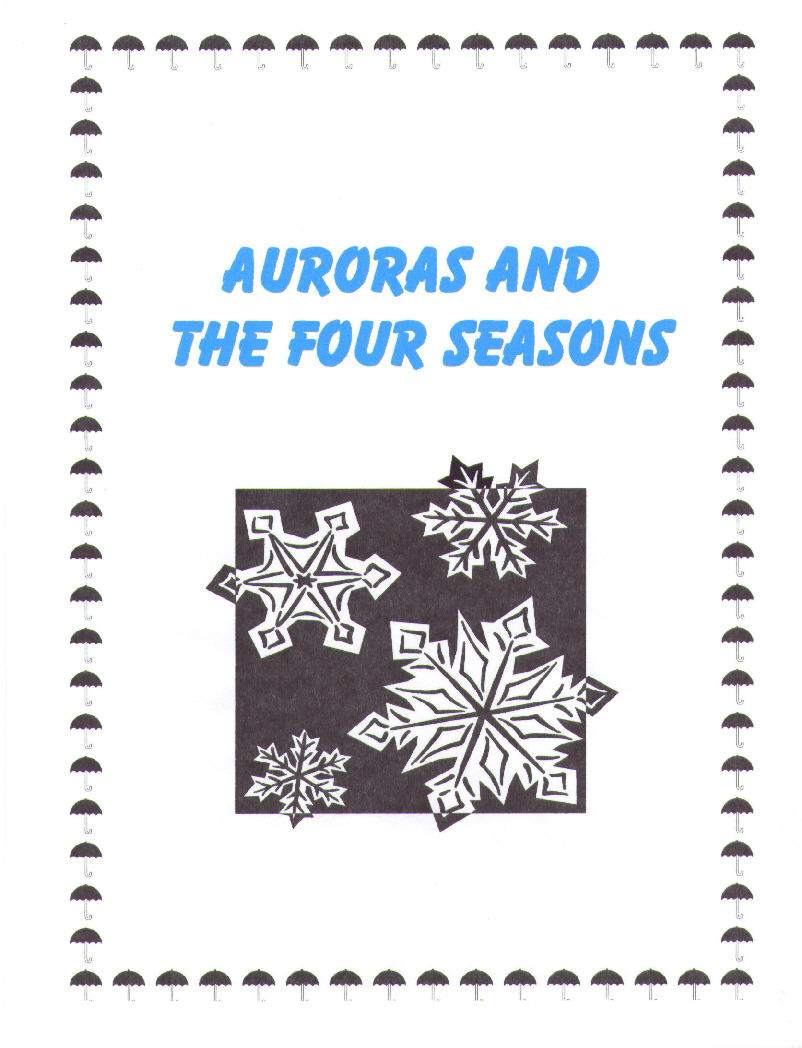
| The weather is a mysterious thing. You probably never knew what causes the weather to change, or why we see the northern lights, but in this essay, you will learn these things and more. In this essay, you will learn about auroras and the always-changing seasons. If you like weather, then this is a report that you will really enjoy! |
Have you ever seen different-colored lights in the sky? If so, then you've probably seen an aurora. Some auroras have names, like the Aurora Borealis (northern lights) and the Aurora Australis (southern lights). These auroras light up the places near the north and south poles, making the sky look beautiful. Some may look red, green, blue, yellow and even all of these colors mixed together! It is a very beautiful sight. You probably are asking yourself: what causes an aurora? Well, that is exactly what I am going to tell you now. Auroras are caused by the Earth pulling high-speed particles that come from the sun's solar flares toward it and hitting the nitrogen and oxygen in the atmosphere, causing the gases to glow. So for every aurora, you need particles from the sun, a powerful magnet (the Earth), and gases. When one of the solar flares hurls out these particles, some of them get stuck in the radiation belts that surround the earth. Then, with the other particles, they dash back and forth between the north and south poles. They put up strong electric activity between the belts. Next, many particles break free into the atmosphere near the two poles. These particles make an electrical charge in the air, which also causes an aurora. For you people who have never seen an aurora, they sometimes look like a faint glow in the sky. Other times they look like a swirl of colors. They can even look like a person's wavy hair. People in Alaska. Canada, Greenland, Iceland, Sweden, Denmark, Norway, and Finland see auroras numerous times every year. Some of those people even read under the aurora's bright light! Now we'll spring right into the four seasons! Spring, summer, fall, and winter: those are the four seasons. They have many differences, but also many similarities. For example, they vary in temperature, from a freezing below 32 degrees Fahrenheit or lower to a sizzling 100 degrees Fahrenheit or higher. The ranges in temperatures differ depending on where you live. Some places are hot all year long, while in other places it is so cold that you need to wear 10 coats. In most places, though, the weather changes depending on what season it is. These four seasons occur because of the way that the earth is tilted on its axis. The axis is tilted on its side, which is the reason why we have the four seasons. If the axis was just straight up and down, then we would have only two seasons: summer and winter. Now I will tell you about each season individually. First, there is spring, which most animals are born in. It is also the season where lots of changes take place. The days start getting warmer and longer. Flowers start blooming and the air smells fresh. There also are a few light showers, but once the sun comes out, you may be able to see a rainbow. Next, there is the hottest season, summer. This season is similar to spring, but the flowers are already in full bloom. The hottest days are in summer and many children mindlessly frolic on these days. Many insects come to pollinate flowers at this time and sometimes rest in the cool shade. FACT: Snowflakes can fall in summer! The snowflakes land on cold mountain tops, but melt on the warmer ground below. The next season, which I am going to tell you about, has two names. Some people call it autumn and some people call it fall. It really doesn't matter what you call it as long as people know what you're talking about. In this season, the weather gets colder and windier. It even rains for a day or two. Leaves start to change colors and fall, hence giving it the name fall. In the mornings and evenings it gets misty. There is also lots of food for the animals in autumn, so they can stock up on food before winter comes. Finally, I will tell you about the season winter. It is the coldest season of the year. The days are short, but the nights are long. Every once in a while it snows, so you need to dress warmly. Sometimes when you go out to play in the snow, you may see footprints from an animal. It's good advice not to follow them, though. These seasons go in a cycle year after year. Every time it is a little different. Well, that is pretty much all of the information that I can give you on seasons. I'll see you later! |
| I hope you've enjoyed this essay that I have put together for you to read. Thank you for reading from the introduction to this part that I wrote. It has been a joy writing this for you. For more information on these exciting topics, check out the books and websites on the following page at your local library. Did you have a nice trip with me? Then I'll see you next fall! |
Books:
Nature All Year Long by Clare Walker Leslie
Northern Lightsby D.M. Souza
Repairing the Damage - Hurricanes and Stormsby Clint Twist
You'd Never Believe It But Snowflakes Can Fall In Summer And Other Facts About The Seasonsby Helen Taylor
Websites:
http://www.theweathercompany.com
http://www.wrh.noaa.gov